25 MG CALPAIN INHIBITOR IIRESEARCH GRADE
- CAS NO.:136632-32-1
- Empirical Formula: C19H35N3O4S1
- Molecular Weight: 401.56
- MDL number: MFCD00065506
- EINECS: 603-969-3
- Update Date: 2023-05-18 11:30:58
What is 25 MG CALPAIN INHIBITOR IIRESEARCH GRADE?
Description
ALLM (136632-32-1) is a cell-permeable, peptide aldehyde inhibitor of calpain (calpain I, Ki?= 120 nM, calpain II, Ki?= 230 nM) and other neutral cysteine proteases. Potent inhibitor of cathepsin L (Ki=0.6 nM) and cathepsin B (Ki=100 nM).1?Weak inhibitor of the chymotrypsin-like activity of the proteasome.2?Cell permeable.
The Uses of 25 MG CALPAIN INHIBITOR IIRESEARCH GRADE
Calpain inhibitor II is a cell-permeable peptide that restricts the activity of calpain, cathepsin L and cathepsin B. Calpain inhibitor II also prevents the methylmercury-induced cell death of cultured rat cerebellar neurons.
The Uses of 25 MG CALPAIN INHIBITOR IIRESEARCH GRADE
ALLM (Calpain Inhibitor) is a cell-permeable, peptide aldehyde inhibitor of calpain I and calpain II. ALLM acts as a very potent inhibitor of cathepsin L and the strongest inhibitor of cathepsin B amongst the peptide aldehydes. This compound inhibits the processing of malaria aspartic hemoglobinases plasmepsins I and II?in vitro. ALLM also inhibits other neutral cysteine proteases, and activation-induced programmed cell death. It restores defective immune responses in HIV+ donors. ALLM blocks nitric oxide production by activated macrophages by interfering with transcription of the inducible nitric oxide synthase gene. ALLM also acts as a weak inhibitor of proteasome.
What are the applications of Application
ALLM (Calpain Inhibitor) is a cell-permeable, peptide aldehyde inhibitor of calpains and cathepsins
Definition
ChEBI: (2S)-2-acetamido-4-methyl-N-[4-methyl-1-[[4-(methylthio)-1-oxobutan-2-yl]amino]-1-oxopentan-2-yl]pentanamide is a peptide.
References
1) Sasaki?et al.?(1990),?Inhibitory effect of di- and tripeptidyl aldehydes on calpains and cathepsins;?J. Enzyme Inhib.,?3?195 2) Vinitsky?et al.?(1992),?Inhibition of the chymotrypsin-like activity of the pituitary multicatalytic proteinase complex; Biochemistry,?31?9421
Properties of 25 MG CALPAIN INHIBITOR IIRESEARCH GRADE
| storage temp. | −20°C |
| solubility | Soluble in ethanol at 20mg/ml |
| form | powder |
| color | white |
| BRN | 7693643 |
| Stability: | Stable for 1 year from date of purchase as supplied. Solutions in DMSO or ethanol may be stored at -20°C for up to 1 month. |
Safety information for 25 MG CALPAIN INHIBITOR IIRESEARCH GRADE
Computed Descriptors for 25 MG CALPAIN INHIBITOR IIRESEARCH GRADE
New Products
Tert-butyl bis(2-chloroethyl)carbamate (S)-3-Aminobutanenitrile hydrochloride N-Boc-D-alaninol N-BOC-D/L-ALANINOL 3-Morpholino-1-(4-nitrophenyl)-5,6-dihydropyridin- 2(1H)-one Furan-2,5-Dicarboxylic Acid Tropic acid N-octanoyl benzotriazole 1,1’-CARBONYLDIIMIDAZOLE R-2-BENZYLOXY PROPIONIC ACID 4-HYDROXY BENZYL ALCOHOL 1,1’-CARBONYLDI (1,2-4 TRIAZOLE) S-2-CHLORO PROPIONIC ACID (2-Hydroxyphenyl)acetonitrile 4-Bromopyrazole 5-BROMO-2CYANO PYRIDINE 5-broMo-2-chloro-N-cyclopentylpyriMidin-4-aMine 2-(Cyanocyclohexyl)acetic acid 4-methoxy-3,5-dinitropyridine 2-aminopropyl benzoate hydrochloride 1-(4-(aminomethyl)benzyl)urea hydrochloride diethyl 2-(2-((tertbutoxycarbonyl)amino) ethyl)malonate tert-butyl 4- (ureidomethyl)benzylcarbamate Ethyl-2-chloro((4-methoxyphenyl)hydrazono)acetateRelated products of tetrahydrofuran








You may like
-
 Thermo Scientific Chemicals Calpain Inhibitor II CAS 136632-32-1View Details
Thermo Scientific Chemicals Calpain Inhibitor II CAS 136632-32-1View Details
136632-32-1 -
 55441-95-7 99%View Details
55441-95-7 99%View Details
55441-95-7 -
 N-Vinylformamide 99%View Details
N-Vinylformamide 99%View Details
13162-05-5 -
 Chloro Uracil 1820-81-1 99%View Details
Chloro Uracil 1820-81-1 99%View Details
1820-81-1 -
 207557-35-5 99%View Details
207557-35-5 99%View Details
207557-35-5 -
 2-ethyl-6-methyl-3-hydroxypyridine succinate 99%View Details
2-ethyl-6-methyl-3-hydroxypyridine succinate 99%View Details
127464-43-1 -
 2-ETHYLPYRIDINE 100-71-0 99%View Details
2-ETHYLPYRIDINE 100-71-0 99%View Details
100-71-0 -
 181228-33-1 (S)-Methyl 3-amino-2-((tert-butoxycarbonyl)amino)propanote Hydrochloride (DAP-OMe. HCl) 99%View Details
181228-33-1 (S)-Methyl 3-amino-2-((tert-butoxycarbonyl)amino)propanote Hydrochloride (DAP-OMe. HCl) 99%View Details
181228-33-1